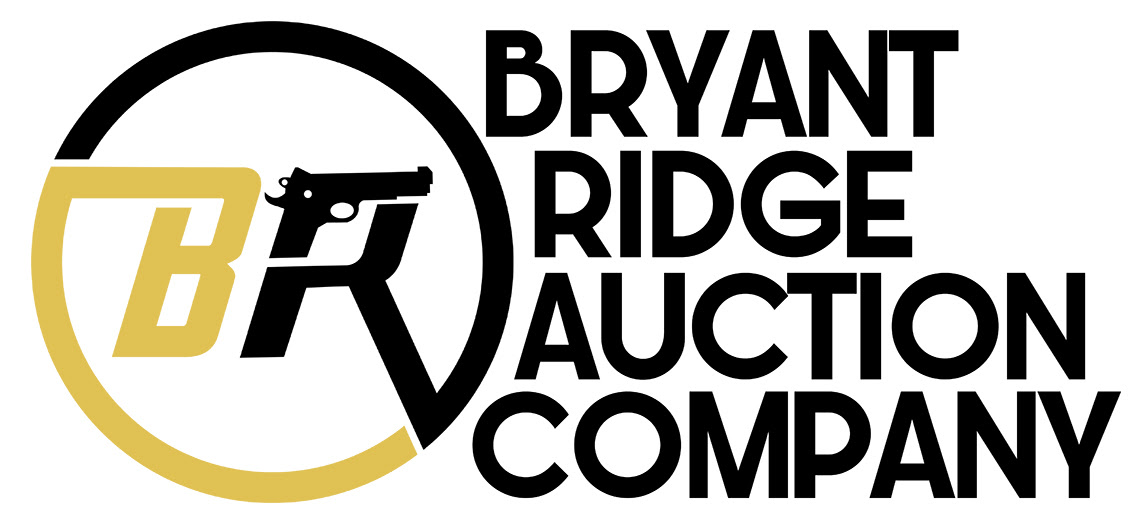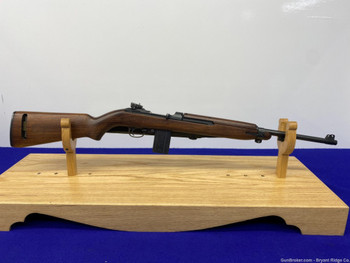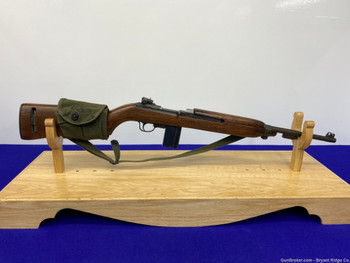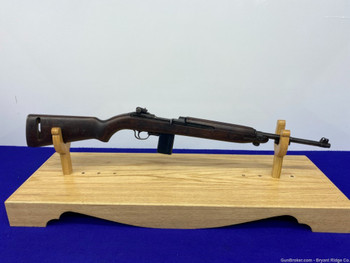Description

Item Description
Bryant Ridge Auction Company is pleased to present this Historical semi-automatic rifle today for a penny-start auction; this is the Saginaw Steering Gear Division of General Motors M1 Carbine!
SPECIFICATIONS:
Manufacturer: Saginaw Steering Gear Division of General Motors
Model: M1 Carbine
Serial: 5860832
Date of Manufacture: 1944
Caliber: .30 Carbine
Finish: Parkerized
Barrel Length: 18"
Optics/Sights: Wing Protected Blade Front with Adjustable Rear Peep
Stock/Grips: Smooth Hardwood
Action: Semi-Automatic
Markings: Standard
Bryant Ridge's Analysis:
In World War Two, the United States Military saw the benefit of having a carbine in its ranks to better suit the needs of troops. This led to the adoption of the M1 Carbine, which was produced in part by the Saginaw Steering and Gear Division Plant of General Motors and other companies. The production of the carbine by Saginaw more efficiently armed a large number of US soldiers during World War II while simultaneously providing a more effective small arm for those soldiers to do their respective duties.
Beginning in 1940, the military had been developing a lightweight rifle to issue to troops who were already encumbered by other equipment or were second-line troops who were not supposed to be in front-line combat. At that time the current small arms issued were either too heavy and bulky or, in the case of the M1911 pistol, limited in range. This led to the pursuit of a carbine using a new .30 caliber round that was lighter than the M1 Garand’s .30-06 round and had more range than the .45 ACP that was in current use. After the completion of development by Winchester and the adoption of the M1 Carbine in September 1941, the government began to contract production runs of the carbine to various private firms. A short time after its introduction Chief of Ordnance, Major General L. H. Campbell Jr., wrote, “Reports coming in from all jungle theaters indicate that the carbine will be a most useful weapon due to its lightweight, small overall length, and the lightweight ammunition. All the above indicates that we must assert the greatest of pressure to get carbines and ammunitions in the minimum of time.”. This is what preceded Saginaw’s contract.
After it’s success with producing the M1919A4 machine gun that began in 1940, Plant #2 obtained a contract for 365,500 M1 Carbines on February 13, 1943. While the plant continued to produce machine guns, the facility took on a series of contracts for M1 Carbines. The Saginaw #2 Plant would produce 293,592 carbines between 1943 and 1944 when the contracts were canceled.
While the Saginaw plant was going forward with its contract, the Ordnance Department requested that Saginaw simultaneously take over the floundering Irwin-Pedersen plant in Grand Rapids, MI. The plant had been established in 1942 for the expressed purpose of building M1 Carbines by Robert W. Irwin, a furniture manufacturer, and John D. Pedersen a commercial firearms designer. Though on the surface, this seemed to be a good, balanced partnership that would produce carbines, in a year, they had produced less than 3,000 units, and none of them had passed inspection with the Ordnance Department. These guns had many parts out of specification and outright catastrophic failure of their receivers. After some deliberation, the Irwins canceled their contract, and Saginaw took over the factory on April 1st, 1943. Some men from the Saginaw plant then led most of the original workforce in completely re-configuring the Grand Rapids Plant. After the plant was taken over, the facility produced 8,000 more carbines than the contract called for, and they were delivered to the government in 33 days. Under the leadership of the Saginaw Division, the Grand Rapids plant produced 223,620 carbines in 1943. With the termination of carbine production, the Grand Rapids plant was transitioned to the G.M.C. diesel program after January 1st, 1944.
Throughout the course of production for the M1 Carbine, the parts to complete guns as needed were subcontracted to over 50 different facilities and businesses that didn’t usually have any prior experience in firearms manufacturing. In addition to subcontracting to fulfill contracts on time, many parts were exchanged between the various main assembly contractors. In the case of Saginaw Steering Gear, the gun stocks came from Rock-Ola Manufacturing Corp. and Trimble Nursery & Furniture Co. As a result, the Saginaw plant never actually made its own stock and avoided setting up that portion of production. While the Saginaw plant made its own rifle barrels during the course of the production at Grand Rapids, they would come from the Inland Division of General Motors, Buffalo Arms, and Saginaw. Many other small parts were sent out to the nine other makers of carbines at different points as was needed to keep production going, ranging in amounts from the hundreds to thousands. Even the most complicated part of the gun, the receiver, which was the serialized center component of the gun that composes the action, was sub-contracted and traded between the 9 makers.
Contents:
*Please Note: This example will NOT ship with a magazine*
Return Policy:
We gladly offer a 3 day unfired inspection policy from the time that the firearm is delivered to your FFL. Refunds are available for all qualifying orders.
Model: M1 Carbine
Serial: 5860832
Date of Manufacture: 1944
Caliber: .30 Carbine
Finish: Parkerized
Barrel Length: 18"
Optics/Sights: Wing Protected Blade Front with Adjustable Rear Peep
Stock/Grips: Smooth Hardwood
Action: Semi-Automatic
Markings: Standard
Bryant Ridge's Analysis:
In World War Two, the United States Military saw the benefit of having a carbine in its ranks to better suit the needs of troops. This led to the adoption of the M1 Carbine, which was produced in part by the Saginaw Steering and Gear Division Plant of General Motors and other companies. The production of the carbine by Saginaw more efficiently armed a large number of US soldiers during World War II while simultaneously providing a more effective small arm for those soldiers to do their respective duties.
Beginning in 1940, the military had been developing a lightweight rifle to issue to troops who were already encumbered by other equipment or were second-line troops who were not supposed to be in front-line combat. At that time the current small arms issued were either too heavy and bulky or, in the case of the M1911 pistol, limited in range. This led to the pursuit of a carbine using a new .30 caliber round that was lighter than the M1 Garand’s .30-06 round and had more range than the .45 ACP that was in current use. After the completion of development by Winchester and the adoption of the M1 Carbine in September 1941, the government began to contract production runs of the carbine to various private firms. A short time after its introduction Chief of Ordnance, Major General L. H. Campbell Jr., wrote, “Reports coming in from all jungle theaters indicate that the carbine will be a most useful weapon due to its lightweight, small overall length, and the lightweight ammunition. All the above indicates that we must assert the greatest of pressure to get carbines and ammunitions in the minimum of time.”. This is what preceded Saginaw’s contract.
After it’s success with producing the M1919A4 machine gun that began in 1940, Plant #2 obtained a contract for 365,500 M1 Carbines on February 13, 1943. While the plant continued to produce machine guns, the facility took on a series of contracts for M1 Carbines. The Saginaw #2 Plant would produce 293,592 carbines between 1943 and 1944 when the contracts were canceled.
While the Saginaw plant was going forward with its contract, the Ordnance Department requested that Saginaw simultaneously take over the floundering Irwin-Pedersen plant in Grand Rapids, MI. The plant had been established in 1942 for the expressed purpose of building M1 Carbines by Robert W. Irwin, a furniture manufacturer, and John D. Pedersen a commercial firearms designer. Though on the surface, this seemed to be a good, balanced partnership that would produce carbines, in a year, they had produced less than 3,000 units, and none of them had passed inspection with the Ordnance Department. These guns had many parts out of specification and outright catastrophic failure of their receivers. After some deliberation, the Irwins canceled their contract, and Saginaw took over the factory on April 1st, 1943. Some men from the Saginaw plant then led most of the original workforce in completely re-configuring the Grand Rapids Plant. After the plant was taken over, the facility produced 8,000 more carbines than the contract called for, and they were delivered to the government in 33 days. Under the leadership of the Saginaw Division, the Grand Rapids plant produced 223,620 carbines in 1943. With the termination of carbine production, the Grand Rapids plant was transitioned to the G.M.C. diesel program after January 1st, 1944.
Throughout the course of production for the M1 Carbine, the parts to complete guns as needed were subcontracted to over 50 different facilities and businesses that didn’t usually have any prior experience in firearms manufacturing. In addition to subcontracting to fulfill contracts on time, many parts were exchanged between the various main assembly contractors. In the case of Saginaw Steering Gear, the gun stocks came from Rock-Ola Manufacturing Corp. and Trimble Nursery & Furniture Co. As a result, the Saginaw plant never actually made its own stock and avoided setting up that portion of production. While the Saginaw plant made its own rifle barrels during the course of the production at Grand Rapids, they would come from the Inland Division of General Motors, Buffalo Arms, and Saginaw. Many other small parts were sent out to the nine other makers of carbines at different points as was needed to keep production going, ranging in amounts from the hundreds to thousands. Even the most complicated part of the gun, the receiver, which was the serialized center component of the gun that composes the action, was sub-contracted and traded between the 9 makers.
Contents:
*Please Note: This example will NOT ship with a magazine*
Return Policy:
We gladly offer a 3 day unfired inspection policy from the time that the firearm is delivered to your FFL. Refunds are available for all qualifying orders.
Shipping Details
Handgun Standard Shipping $50.00
Long Gun Standard Shipping $70.00
Any orders placed with magazines that are not compliant with your state, county, or city regulations will not ship with your order.
















